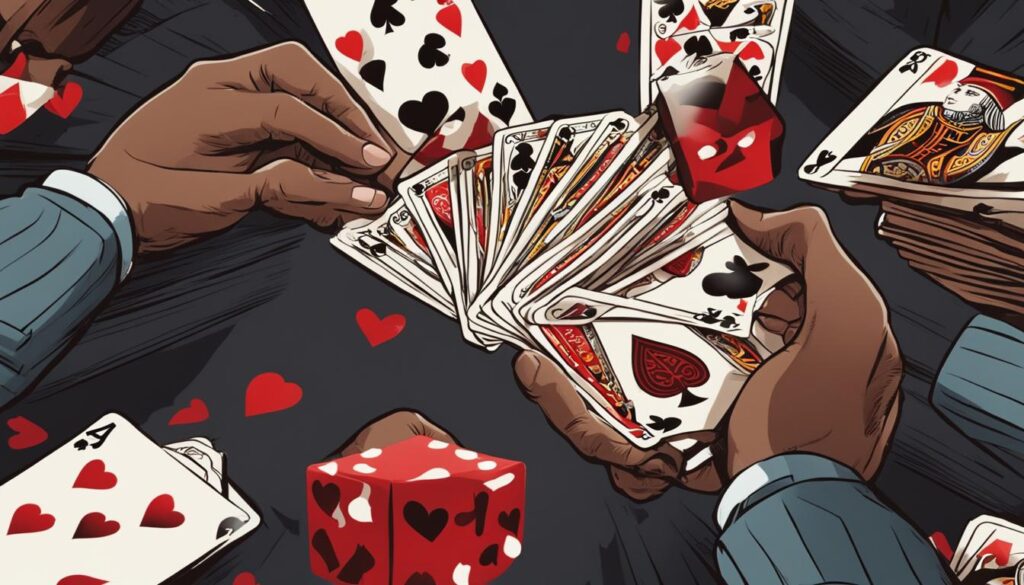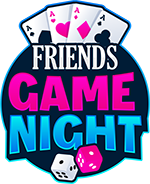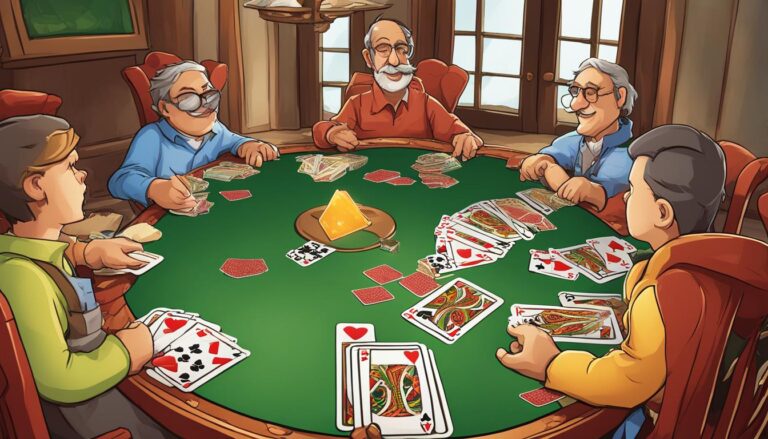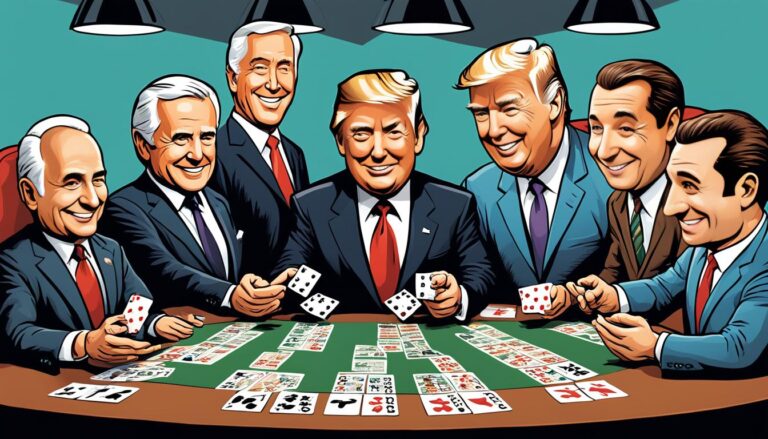Disclosure: This Post Contains Affiliate Links; We earn a commission on purchases.
Welcome to our guide on Hearts card game strategy! In this article, we will explore tips and tricks for mastering the game and avoiding the dreaded Queen of Spades. Whether you’re a beginner or a seasoned player, developing a strategic approach is essential for minimizing point accumulation and improving your chances of winning.
Hearts is a classic card game played with four players and a standard 52-card deck. The objective is to avoid taking hearts and, most importantly, the Queen of Spades, which carries a hefty 13 points. By employing smart strategies, you can navigate the game with finesse and outmaneuver your opponents.
Key Takeaways:
- Understand the objective of Hearts: to avoid taking hearts and the Queen of Spades.
- Develop a strategic approach: plan your moves to minimize point accumulation.
- Master the passing phase: choose cards to pass that will not jeopardize your strategy.
- Avoid winning tricks with hearts and high spades to minimize point accumulation.
- Consider ducking strategies: intentionally play lower cards to avoid winning tricks.
Table of Contents
Basic Rules of Hearts Card Game
Hearts is a classic card game that requires strategy and skill. Understanding the basic rules is essential for success in this popular game.
Here are the key rules of the Hearts card game:
Objective
The objective of Hearts is to score the lowest number of points. Points are accumulated by winning tricks that contain hearts or the dreaded Queen of Spades.
Deck
Hearts is played with a standard 52-card deck. The deck consists of four suits: hearts, spades, diamonds, and clubs. Each suit has thirteen cards, totaling 52 cards.
Number of Cards
At the beginning of the game, each player is dealt thirteen cards. In total, there are four players, so the game is played with a full deck of 52 cards.
Order of Play
Each round begins with the player holding the 2 of clubs leading the first trick. Players must follow suit if they have a card of the same suit. If a player doesn’t have a card of the led suit, they can play any card from their hand.
Scoring
Points are awarded for winning tricks that contain hearts and the Queen of Spades. In each round, all hearts are worth 1 point, while the Queen of Spades carries a hefty 13 points. The goal is to avoid winning tricks with these high-value cards.
Game End
The game continues until a player reaches or exceeds the predetermined score limit, typically 100 points. At that point, the player with the lowest point total wins the game.
| Card | Point Value |
|---|---|
| Hearts | 1 |
| Queen of Spades | 13 |
Playing Hearts can be an exciting and challenging experience. By understanding these basic rules, players can embark on their hearts journey with confidence and strategically build their gameplay to avoid collecting unwanted points.
Passing Strategies in Hearts Card Game
One of the key aspects of the Hearts card game is the passing phase at the beginning of each round. During this phase, players must carefully select three cards from their hand to pass to another player. This strategic decision plays a crucial role in shaping your hand and avoiding problematic cards that could result in accumulating points.
When choosing which cards to pass, it is important to consider the potential risks and benefits. The ultimate goal is to minimize the chances of winning hearts and the dreaded Queen of Spades, which carries a high value of 13 points. By passing undesirable cards and potentially receiving helpful ones, you can improve your overall strategy and increase your chances of success.
Passing Low Hearts
One passing strategy is to pass low hearts to your opponents. By doing so, you make it more difficult for them to shoot the moon, which is when a player takes all the hearts and the Queen of Spades in a single round. Passing low hearts forces opponents to rely on other players for fulfilling their shooting ambitions, increasing the likelihood of distributing points across multiple players instead of concentrating them in a single hand.
Passing Spades with Caution
While passing low hearts can be advantageous, passing spades requires caution. If you pass high spades, such as the King or Ace, to another player, you run the risk of being forced to take the Queen of Spades if that player leads with them. It is crucial to evaluate your hand and consider the potential consequences before passing spades, especially the higher-ranking ones.
To illustrate these passing strategies, consider the following example:
| Your Hand | Pass to Player A | Pass to Player B | Pass to Player C |
|---|---|---|---|
| [2♥, 4♥, 5♠, 7♠, 10♠, K♦, K♠, A♣, A♠, 3♦, 6♣, 9♠, Q♣] | [2♥, 4♥, 5♠] | [7♠, 10♠, K♦] | [K♠, A♣, A♠] |
In this example, you prioritize passing low hearts to minimize the chances of opponents shooting the moon. You also pass high spades to different players, preventing any single player from leading with them and potentially forcing you to take the Queen of Spades.
By employing strategic passing strategies based on the composition of your hand, you can enhance your overall gameplay and increase your chances of avoiding high-scoring cards in Hearts.
Strategies for Avoiding the Queen of Spades
The Queen of Spades is a highly undesirable card in Hearts because it carries 13 points. To increase your chances of avoiding this card and minimizing point accumulation, you need to employ strategic gameplay techniques. Here are some effective strategies:
- Avoid owning the Queen of Spades: If possible, try to get rid of or pass away this high-scoring card during the passing phase at the beginning of each round. This will eliminate the risk of being forced to win a trick containing the Queen.
- Avoid high spades: Apart from the Queen of Spades, high spades such as the King and Ace can also lead to point accumulation. It is crucial to avoid owning these cards or playing them strategically when necessary, as they increase the chances of other players taking tricks with the Queen, consequently reducing your point accumulation.
By implementing these strategies, you can greatly improve your chances of avoiding the Queen of Spades and accumulating fewer points in the game of Hearts.
| Card | Point Value |
|---|---|
| Queen of Spades | 13 |
| All other hearts | 1 |
As shown in the table above, the Queen of Spades carries the highest point value among all cards in the Hearts card game. Avoiding it should be a top priority to secure victory.
Ducking Strategies in Hearts Card Game
In the game of Hearts, ducking is a clever and strategic maneuver that involves intentionally playing lower cards than necessary to avoid winning a trick. By employing this tactic, players aim to minimize their point accumulation and increase the likelihood of their opponents getting stuck with high cards. However, it is important to exercise caution when implementing ducking strategies, as it carries the risk of getting stuck with high cards near the end of the round.
“Ducking in Hearts card game is like a delicate dance, where players skillfully navigate the flow of the game by tactically playing lower cards, allowing others to take the trick.”
Ducking plays a vital role in the overall strategy of Hearts, as it helps players avoid winning high-scoring cards like hearts and the Queen of Spades. By playing low cards instead of their higher counterparts, players can strategically influence the dynamics of the game and redirect the points towards their opponents.
Although ducking can be an effective way to minimize point accumulation, it requires thoughtful consideration. Players must evaluate the current state of the game and their hand’s composition before deciding when and how to duck. Too much reliance on ducking can result in undesirable consequences, as opponents may eventually catch on and take advantage of the player’s hesitancy to play higher cards.
Nevertheless, when executed strategically, ducking can be a powerful weapon in an experienced Hearts player’s arsenal. It can disrupt opponents’ plans, force them to take high-scoring cards, and allow the player to maintain a favorable position in the game.
Playing Low Cards for Maximum Impact
To effectively employ ducking strategies, players should prioritize playing lower cards in specific situations. Here are some key tactics to keep in mind:
- When leading a trick, play the lowest card of a non-scoring suit to minimize the risk of taking a high-scoring card.
- When a trick contains high cards and a player has the option to play a low card, they can deliberately choose to do so to avoid winning the trick.
- Strategically playing low cards when opponents start running out of a certain suit can limit their options and divert the accumulation of points towards them.
- Be mindful of the count of cards played in each suit, as it can provide valuable information about the likelihood of opponents having high cards.
By employing these ducking strategies and playing low cards, players can manipulate the gameplay and minimize their point accumulation, giving them a competitive edge in the game of Hearts.
Now that we’ve explored the art of ducking in Hearts card game, let’s move on to another vital aspect of the game: strategic passing of cards.
Strategic Passing of Cards in Hearts Card Game
Effective passing of cards during the start of each round can significantly impact your game strategy in Hearts. It is important to strategically pass away bad shooting cards to minimize the risk of accumulating points. By passing these cards to opponents, you can not only hinder their progress but also improve your chances of success.
When deciding which cards to pass, focus on avoiding bad shooting cards such as the Queen of Spades, high spades, and high hearts. These cards carry high point values and can lead to substantial point accumulation if won as tricks. By passing them away, you reduce the likelihood of opponents obtaining them and gaining an advantage in the game.
Additionally, consider using the strategy of passing low hearts as shooting deterrents. By passing low heart cards, you discourage opponents from attempting to shoot the moon, which involves winning all the hearts and the Queen of Spades. Passing low hearts can make it more challenging for opponents to achieve this risky but rewarding feat, thereby reducing their point earning potential.
Furthermore, sloughing your lowest suit can be an effective strategy to hinder opponents. This involves passing away cards from your lowest suit, making it more difficult for opponents to get rid of unwanted high cards. Sloughing can disrupt opponents’ game plans and force them to take unwanted cards, increasing their point accumulation and potentially benefiting your own strategy.
Remember, the passing phase in Hearts is your opportunity to shape your hand and improve your chances of winning. By strategically passing bad shooting cards, low hearts as deterrents, and sloughing your lowest suit, you can manipulate the direction of the game and enhance your overall gameplay. Use this phase wisely to set yourself up for success in the rounds to come.
Developing Safe and Targeting Hands in Hearts Card Game
In a game of Hearts, players often face the decision of whether to pursue safe hands or targeting hands. Safe hands are characterized by low-value cards and the absence of the Queen of Spades, enabling players to consistently duck and avoid winning tricks. On the other hand, targeting hands involve intentionally acquiring the Queen of Spades and cards that can be strategically dumped on specific players to increase their point accumulation.
The choice between safe and targeting hands depends on the state of the game and the scoring situation. Let’s explore both strategies in detail:
Safe Hands
A safe hand typically consists of low-ranking cards, usually with a focus on avoiding hearts and the Queen of Spades. By intentionally holding onto low-value cards, players can continuously duck and successfully avoid winning tricks. The objective is to minimize point accumulation and strategically distribute the burden of receiving high-value cards among opponents.
Targeting Hands
Contrary to safe hands, targeting hands involve a deliberate effort to acquire the Queen of Spades and specific cards to dump on opponents. This strategy aims to increase the point accumulation of targeted players, making it more challenging for them to secure a victory. Targeting hands may be employed when a player wants to disrupt the gameplay of a leading opponent or when there is a need to balance point distribution.
Understanding the current state of the game and the scoring situation is crucial when deciding between safe and targeting hands. By carefully assessing the gameplay dynamics and strategic opportunities, players can make informed choices that maximize their chances of success.
“In Hearts, the choice between safe and targeting hands is like a delicate balancing act. It requires a keen understanding of the game’s dynamics and the ability to adapt to changing situations.” – Emily Thompson, Hearts Card Game Expert
By employing safe and targeting hands strategically, players can enhance their gameplay and increase their chances of winning in the challenging and exciting world of Hearts card game.

Shooting Strategies in Hearts Card Game
Shooting in the Hearts card game is a daring strategy that involves attempting to win all the point-scoring cards, including the hearts and the Queen of Spades. While this strategy can be risky, it can also yield substantial rewards if executed successfully. To shoot for all points, players must carefully plan their moves and make strategic decisions based on the cards they possess and the cards played by their opponents.
One key aspect of shooting is to hold on to high cards until the right moment. By keeping high-value cards like the King and Ace, players can increase their chances of capturing valuable tricks. Playing their high cards strategically can also force opponents to play their higher cards, leaving them with limited options to avoid capturing point-scoring cards.
Smart shooting requires a keen observation of the cards that have already been played. By paying attention to the cards in play, players can deduce the potential cards their opponents hold and adjust their strategy accordingly. Additionally, understanding opponents’ tendencies can provide valuable insights into their potential shooting strategies, allowing players to anticipate their moves and counteract effectively.
“Shooting in Hearts is like taking a calculated risk. It’s about patience, timing, and understanding the game state. If executed correctly, shooting can turn the tide in your favor and lead to a big scoring advantage.”
– Expert Hearts Player
While shooting can be a thrilling and high-stakes strategy, it should be approached with caution. It’s essential to evaluate the current game state, the scores, and the potential consequences of capturing point-scoring cards. Sometimes, it may be wise to abandon the shooting strategy if the risk outweighs the potential rewards.
Now, let’s take a look at the shooting strategy table, which outlines crucial considerations and tips for executing successful shooting strategies:
| Shooting Strategy | Explanation |
|---|---|
| Hold on to high cards | Keep high-value cards like the King and Ace to increase your chances of capturing valuable tricks. |
| Lead with low cards | Strategically play low cards to force opponents to play their higher cards, limiting their ability to avoid capturing point-scoring cards. |
| Observe played cards | Pay attention to the cards already played to gain insights into the potential cards your opponents hold and adjust your strategy accordingly. |
| Understand opponents’ tendencies | By understanding your opponents’ shooting tendencies, you can anticipate their moves and counteract effectively. |
By following these shooting strategies and considering the table’s insights, players can enhance their chances of executing successful shooting maneuvers while playing the Hearts card game.
Remember, shooting in Hearts is a calculated risk that requires careful analysis and strategic decision-making. Only by honing your skills and adapting to different game situations will you become a master of shooting and maximize your point accumulation in the game.
Strategies for Stopping Shoots in Hearts Card Game
To prevent opponents from successfully shooting in Hearts, players can employ various strategies. By implementing these tactics, you can minimize the risk of accumulating points and secure a stronger position in the game. Let’s explore some effective methods for stopping shoots and preventing shooting attempts.
1. Pass Low Hearts and Undesirable Cards
During the passing phase, it is crucial to get rid of low hearts and other undesirable cards. By passing these cards to opponents, you make it harder for them to shoot successfully. This strategy not only reduces the chances of opponents winning tricks with hearts but also hampers their ability to score points with the Queen of Spades.
2. Keep High Cards, Especially the Ace
Having high cards in your hand can provide valuable protection against shooting attempts. Keeping cards like the Ace can help in blocking opponents from winning tricks containing scoring cards. By strategically playing your high cards, you can disrupt their shooting plans and safeguard your point accumulation.
3. Recognize Signs of Shooting
Observing the gameplay and recognizing signs of shooting can give you an advantage in stopping shoots. Pay close attention when opponents play low cards on high tricks, as this may indicate their intent to shoot the moon or accumulate points with the Queen of Spades. By identifying these patterns, you can devise countermeasures and strategically play your cards to thwart their shooting attempts.
By incorporating these strategies into your Hearts gameplay, you can effectively prevent opponents from shooting and minimize the risk of accumulating points. Remember, careful observation, strategic passing, and keeping high cards are key elements in achieving success in the game.

Conclusion
Developing a solid strategy in the Hearts card game is key to improving your gameplay and increasing your chances of winning. By focusing on avoiding the Queen of Spades and minimizing point accumulation, players can gain a competitive edge. Throughout this guide, we have explored various expert strategies that can help you navigate the game with confidence.
Strategic passing of cards allows you to shape your hand and minimize the risk of winning hearts and the Queen of Spades. Ducking, or intentionally playing low cards, can help you avoid unnecessary tricks and reduce your point tally. Alternatively, developing safe hands with low cards and no Queen of Spades allows for continuous ducking, while targeting hands involving the Queen can increase your opponents’ point accumulation.
Shooting strategies, although risky, can be rewarding if executed with precision. By carefully observing played cards and anticipating your opponents’ moves, you can strategically lead low cards to force them to play their higher ones. Conversely, stopping shoots requires passing low hearts, keeping high cards for protection, and recognizing signs of shooting attempts.
With practice and experience, you can master these expert strategies and improve your success rate in the Hearts card game. Remember to adapt your approach based on the state of the game and the scoring situation. Whether you choose to play it safe or take calculated risks, a well-rounded strategy will undoubtedly elevate your gameplay.

As the founder of Friends Game Night, Ryan channels his enthusiasm for gaming into a platform that celebrates the magic of gathering friends around the digital or physical tabletop. Through his website, Ryan shares insightful articles, reviews, and recommendations, aiming to inspire others to create their own memorable gaming moments.
Subscribe to Our Newsletter










